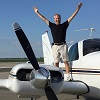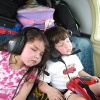10 Nov 2025, 09:01 [ UTC - 5; DST ]
|

| Username Protected |
Message |
|
Username Protected
|
Post subject: Re: Helicopters - single rotor vs dual rotor  Posted: Posted: 05 Jun 2022, 11:01 |
|
 |

|
|
 |

Joined: 01/31/12
Posts: 3027
Post Likes: +5452
Company: French major
Location: France
Aircraft: Ejet
|
|
Username Protected wrote: I read that the Chinook is the fastest current helicopter. So no tail rotor must help there. And also that the mechanism that translates the cyclic and pedals into what the pilot intends is akin to magic.  Just a minor correction, the Lynx still holds the record for speed...
_________________
Singham!
|
|
| Top |
|
|
Username Protected
|
Post subject: Re: Helicopters - single rotor vs dual rotor  Posted: Posted: 05 Jun 2022, 18:33 |
|
 |

|

|
 |

Joined: 04/26/13
Posts: 21890
Post Likes: +22558
Location: Columbus , IN (KBAK)
Aircraft: 1968 Baron D55
|
|
Why would you use either dual (Chinook) rotors, or intermeshing vs concentric, contra-rotating systems like the KA-50?
_________________
My last name rhymes with 'geese'.
|
|
| Top |
|
|
Username Protected
|
Post subject: Re: Helicopters - single rotor vs dual rotor  Posted: Posted: 05 Jun 2022, 19:00 |
|
 |

|
|
 |

Joined: 11/15/09
Posts: 1858
Post Likes: +1356
Location: Red Deer, Alberta (CRE5/CYQF)
Aircraft: M20E/Bell47
|
|
Username Protected wrote: I read that the Chinook is the fastest current helicopter. So no tail rotor must help there.
... The limiting factor for forward speed in a "normal" rotor system is the retreating blade stall. The blade tips on my Bell 47 rotate at almost exactly 200mph. If I am going forward at 100 mph, the right (forward moving) blade tip "sees" a 300 mph airflow over it while the left (rear moving) blade tip sees a 100 mph airflow. If you go forward fast enough at some point the outer parts of the blade going "backwards" has no airflow over it and stalls. In a dual rotor system like the Chinook the blades rotates in the opposite directions so each rotor would have a retreating blade on opposite sides of the helicopter limiting (balancing?) its effects.
|
|
| Top |
|
|
Username Protected
|
Post subject: Re: Helicopters - single rotor vs dual rotor  Posted: Posted: 05 Jun 2022, 19:00 |
|
 |

|
|

Joined: 11/16/13
Posts: 41
Post Likes: +109
Company: Envisioneering Inc.
Aircraft: 1965 Cessna 172F
|
|
|
Hello all. Long time lurker, first time poster.
I've been a Chinook Flight Engineer for going on 24 years, and closing on 5000 flight hours. Lots of correct answers here. Yes, 5 transmissions. One forward, one aft, one combining, and two engine transmissions. 11 driveshafts connect it all together. Dual fully articulated rotor heads, with three fiberglass rotor blades rotor blades apiece. The blades weigh around 350 lbs. each. Twin T55-GA-714 engines produce around 3750 SHP continuous with up to 4500 SHP in contingency power. Max gross weight of the -47G is 54,000lbs, but I will tell you it won't get anywhere near 200 kts without a significant tailwind. I have seen 205-210 GS at altitude heading east in the winter. Normal cruise is around 110-120 knots, and there is a gauge in the cockpit to measure rotor system stress that must be satisfied depending on gross weight and altitude.
The tandem rotor design gives a very generous center of gravity for both internal and external loads, and is a very stable platform. With the Digital Advanced Flight Control System (DAFCS) it is laughably easy to fly. The configuration is a bit different then conventional helicopters in that the pitch attitude is controlled by differential collective pitch, meaning if you pull back on the stick, the forward head increases collective more than the aft head causing the nose to rise, and vice versa for forward stick. Roll is simple, and yaw is controlled by the rotor systems tilting opposite directions. Interestingly enough, the Chinook can yaw around the center fuselage, the forward or aft head by simply cross controlling the aircraft.
Thanks for starting this thread so I finally have something to contribute!
V/r,
Brad
|
|
| Top |
|
|
Username Protected
|
Post subject: Re: Helicopters - single rotor vs dual rotor  Posted: Posted: 05 Jun 2022, 19:21 |
|
 |

|
|

Joined: 04/21/16
Posts: 725
Post Likes: +350
|
|
Username Protected wrote: Hello all. Long time lurker, first time poster.
I've been a Chinook Flight Engineer for going on 24 years, and closing on 5000 flight hours. Lots of correct answers here. Yes, 5 transmissions. One forward, one aft, one combining, and two engine transmissions. 11 driveshafts connect it all together. Dual fully articulated rotor heads, with three fiberglass rotor blades rotor blades apiece. The blades weigh around 350 lbs. each. Twin T55-GA-714 engines produce around 3750 SHP continuous with up to 4500 SHP in contingency power. Max gross weight of the -47G is 54,000lbs, but I will tell you it won't get anywhere near 200 kts without a significant tailwind. I have seen 205-210 GS at altitude heading east in the winter. Normal cruise is around 110-120 knots, and there is a gauge in the cockpit to measure rotor system stress that must be satisfied depending on gross weight and altitude.
The tandem rotor design gives a very generous center of gravity for both internal and external loads, and is a very stable platform. With the Digital Advanced Flight Control System (DAFCS) it is laughably easy to fly. The configuration is a bit different then conventional helicopters in that the pitch attitude is controlled by differential collective pitch, meaning if you pull back on the stick, the forward head increases collective more than the aft head causing the nose to rise, and vice versa for forward stick. Roll is simple, and yaw is controlled by the rotor systems tilting opposite directions. Interestingly enough, the Chinook can yaw around the center fuselage, the forward or aft head by simply cross controlling the aircraft.
Thanks for starting this thread so I finally have something to contribute!
V/r,
Brad Thanks for that Brad. I'm familiar with the mast moment indicator on some hingeless rotor systems, is the "gauge in the cockpit" you refer to on the CH-47 similar? A mast strain measurement?
Last edited on 05 Jun 2022, 19:22, edited 1 time in total.
|
|
| Top |
|
|
Username Protected
|
Post subject: Re: Helicopters - single rotor vs dual rotor  Posted: Posted: 05 Jun 2022, 19:22 |
|
 |

|
|
 |

Joined: 11/15/09
Posts: 1858
Post Likes: +1356
Location: Red Deer, Alberta (CRE5/CYQF)
Aircraft: M20E/Bell47
|
|
Username Protected wrote: ...
I've been a Chinook Flight Engineer for going on 24 years, and closing on 5000 flight hours.
...
Brad So...what's the ratio of maintenance hours/flight hours on a Chinook?
|
|
| Top |
|
|
Username Protected
|
Post subject: Re: Helicopters - single rotor vs dual rotor  Posted: Posted: 05 Jun 2022, 19:29 |
|
 |

|
|

Joined: 11/16/13
Posts: 41
Post Likes: +109
Company: Envisioneering Inc.
Aircraft: 1965 Cessna 172F
|
|
Username Protected wrote: Thanks for that Brad. I'm familiar with the mast moment indicator on some hingeless rotor systems, is the "gauge in the cockpit" you refer to on the CH-47 similar? A mast strain measurement? Ed, There are strain gauges mounted to a fixed link on both the forward and aft swashplates. It's basically a wire that changes resistance as it's compressed or stretched, based on the stress to that fixed link, and that signal is measured and processed by a box and sent to either a gauge in the cockpit or displayed on an MFD. Green is good, yellow is meh, and red is bad, so do something to get it back into the green! V/r, Brad
|
|
| Top |
|
|
Username Protected
|
Post subject: Re: Helicopters - single rotor vs dual rotor  Posted: Posted: 05 Jun 2022, 19:42 |
|
 |

|
|

Joined: 04/21/16
Posts: 725
Post Likes: +350
|
|
Username Protected wrote: ...
I've been a Chinook Flight Engineer for going on 24 years, and closing on 5000 flight hours.
...
Brad So...what's the ratio of maintenance hours/flight hours on a Chinook?
Don't know, but the inter government agency hourly cost rate for a CH-47F is less than that for an N model Huey. That is surprising.
|
|
| Top |
|
|
Username Protected
|
Post subject: Re: Helicopters - single rotor vs dual rotor  Posted: Posted: 05 Jun 2022, 19:56 |
|
 |

|
|

Joined: 11/16/13
Posts: 41
Post Likes: +109
Company: Envisioneering Inc.
Aircraft: 1965 Cessna 172F
|
|
Username Protected wrote: So...what's the ratio of maintenance hours/flight hours on a Chinook? Glenn, Great question and one I don't know the answer to off the top of my head. There are many metrics and tools to define it. Our computerized logbook system could probably spit that number out, but I'm not sure as to it's authenticity. I can tell you that it generally takes me and another experienced flight engineer about an hour and change to complete a Preventative Maintenance Daily (PMD) inspection. We do that prior to the pilots showing up to preflight, which is just another set of eyes looking at everything. My PMD is more in-depth than the preflight. On completion of the flight, I do a post flight which basically consists of a quick visual check on the major components, filter buttons, and fluid levels. V/r, Brad
|
|
| Top |
|
|
Username Protected
|
Post subject: Re: Helicopters - single rotor vs dual rotor  Posted: Posted: 05 Jun 2022, 20:40 |
|
 |

|
|

Joined: 08/03/13
Posts: 2638
Post Likes: +5675
Location: SW Colorado
Aircraft: C182
|
|
|
The CH47 Chinook has a feature not present in other stuff I’ve been on-the hell hole.
The opening is enormous when you’re trying to get around without chicken strap on. The opening is tiny when you’re getting sucked back into the ship.
Please login or Register for a free account via the link in the red bar above to download files.
|
|
| Top |
|
|
Username Protected
|
Post subject: Re: Helicopters - single rotor vs dual rotor  Posted: Posted: 11 Jun 2022, 19:06 |
|
 |

|
|

Joined: 01/04/17
Posts: 113
Post Likes: +35
|
|
|
If you want to go fast, just tilt your rotors.
V-22 top speed is 270 Kts @ Sea Level.
|
|
| Top |
|

|
You cannot post new topics in this forum
You cannot reply to topics in this forum
You cannot edit your posts in this forum
You cannot delete your posts in this forum
You cannot post attachments in this forum
|

Terms of Service | Forum FAQ | Contact Us
BeechTalk, LLC is the quintessential Beechcraft Owners & Pilots Group providing a
forum for the discussion of technical, practical, and entertaining issues relating to all Beech aircraft. These include
the Bonanza (both V-tail and straight-tail models), Baron, Debonair, Duke, Twin Bonanza, King Air, Sierra, Skipper, Sport, Sundowner,
Musketeer, Travel Air, Starship, Queen Air, BeechJet, and Premier lines of airplanes, turboprops, and turbojets.
BeechTalk, LLC is not affiliated or endorsed by the Beechcraft Corporation, its subsidiaries, or affiliates.
Beechcraft™, King Air™, and Travel Air™ are the registered trademarks of the Beechcraft Corporation.
Copyright© BeechTalk, LLC 2007-2025
|
|
|
|



